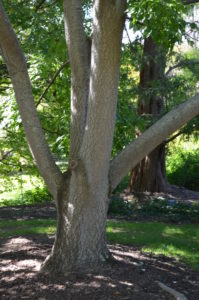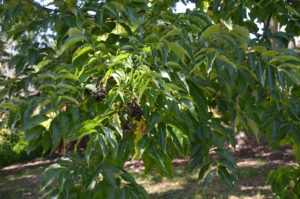Amur corktree (Phellodendron amurense) is native to Northern China, Korea and Japan (USDA hardiness zones 4-9). Amur corktree is a fast growing, upright branched tree that makes an excellent yard or shade tree. Corktree grows in a wide range soils, and tolerates soil pH between 5.0 to 8.2. It does best in moist, well-drained soils, but it can stand dryer soils and conditions. It is drought tolerant and does well in areas of high heat and cold.
Amur corktree was a good choice for use on large properties such as golf courses, industrial sites, and urban parks where its wide shallow rootsystem has room to grow. Roots rarely interfere with underground utility lines as will sycamores (Platanus) or willows (Salix). Use as a street tree is questionable as corktree does not prosper in compact droughty soils. Its pinnately compound foliage is also tolerant of many air-borne pollutants common in urban environments.
The spreading branches of corktree cast lots of shade. This medium sized tree will reach heights of 30 to 50 feet, with its branch spread similar to its height. The tree is often seen multi-trunked. A second corktree species, Lavalle corktree (P. lavallei), is almost identical in all traits except branching that tends to be more upright.
Corktree is dioecious, e.g., a female tree produces inconspicuous flowers that give rise to sweet drupe fruits. As its common name suggests, Amur corktree exhibits distinctive porous (spongy) bark texture. Leaves, when crushed, emit a variety of scents that some described as “citrusy”.
Cultivars:
‘His Majesty’ (P. sachalinense x P. amurense) – male, fruitless, broadly vase-shaped, yellow fall color),
Eye Stopper ™ (P. lavallei ‘Long Necker’) – selected for bright yellow fall color; slightly less corky bark
Macho® (P. amuerense) – vigorous male, fruitless, broadly vase- shaped, tree.
Shademaster® (‘PNI 4551’) – male fruitless with glossy foliage,
Superfection™ (‘Supzam’) – male fruitless, upright-uniform branching habit
Important Note: Amur corktree is considered invasive in parts of the northeastern U.S. where it may outcompete native species.



 Posted in
Posted in 
